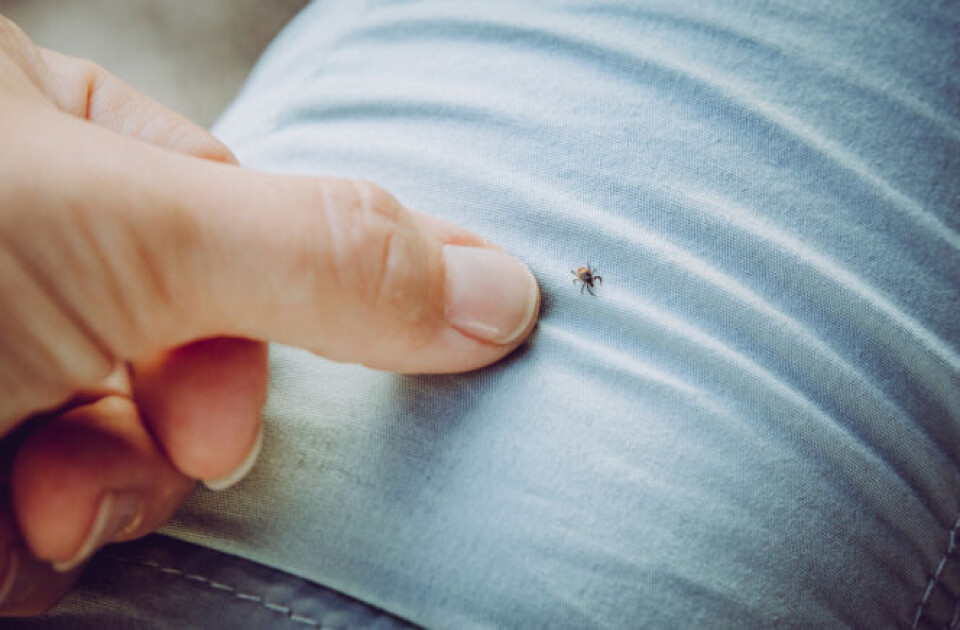-
UK-EU talks raise hopes of easing post-Brexit rules for Britons in France
Several proposals and plans could ease some post-Brexit complications
-
French study claims ‘Dry January’ participation improves sleep and health
First major study of its kind in France praises challenge, but alcohol-free month is yet to receive official endorsement
-
Egg shortages continue in France after bird flu and weather chaos
Sales rose by 300 million eggs between 2024 and 2025 as producers struggle to meet demand
Lyme disease: Number of people bitten by a tick rising in France
Not all ticks can cause the disease but we explain where Lyme is most common and how to prevent bites

A third of people in France have been bitten by a tick and this figure is rising, despite increased awareness campaigns on the dangers of Lyme disease (around 15% of ticks in France carry Lyme).
Lyme disease is a bacterial infection that can be spread to humans by infected ticks, but not all ticks are carriers. The chance of catching Lyme disease depends on the tick species, where it came from and how long it was biting you.
New figures from health body Santé publique France (SPF), published on February 22, show that the number of people who have been bitten, and the number who feel they may have been at risk of being bitten by ticks, is on the rise.
This comes in the context of reinforced information campaigns on the dangers of tick bites which have been launched since 2016. The increase in the number of bites being spotted could either show that people are now more aware of the signs to look out for or that bites really are becoming more common.
SPF conducted its latest health report by comparing barometers from 2016 and 2019, each done via a telephone survey of a nationally-representative sample of people in France aged 18-85.
The figures show that in 2019, 30% of people said they had been bitten by a tick in their life, and 6% had been so over the past 12 months. This is a 25% and 4% rise respectively compared to 2016.
And in 2019, 25% of the population said they generally felt exposed to tick bites, compared to 23% in 2016.
There has also been a slight rise in the number of people reporting tick bites over the past 12 months, figures from 2016-2019 show.
SPF also noted that there has been a rise in the number of reports of Lyme over the past few years, which is “partly” linked to “increased awareness of the population”, SPF said.
Awareness of the disease has risen especially in areas most at risk, it said, largely as a result of educational campaigns.
Read more:New campaign to alert walkers to risk of Lyme disease in France
In 2016, the Health Ministry launched an information campaign due to pressure from Lyme disease associations, in a bid to raise awareness of how to prevent the tick-borne condition.
The national prevention campaign was mounted by regional health agencies les Agences régionales de santé (ARS), SPF, and patient associations, across radio and TV; as well as on posters, signs at the entrance to forests, and in doctors’ offices.
SPF said that this had had a positive effect. In 2016, 66% of people said they had heard of Lyme, which had risen to 79% by 2019. Similarly, 29% felt “well informed” on the risks in 2016, versus 41% in 2019.
Prevention measures are more likely to be taken by people aged 55 and over, and those living in high-risk areas, SPF said.
Where do most bites happen?
The majority (52%) happen in forests, but also in fields and meadows (22%) and in gardens (16%). Most bites are reported by people who work outdoors, such as farmers or forest workers, SPF said.
How do people generally try to prevent bites?
SPF said that among those who felt “exposed to (at risk of)” bites, almost three quarters (73%) wore covering clothes when outdoors, more than half (54%) had remembered to check their bodies for bites, and 18% used repellent spray.
However, these measures were not applied systematically; only 34% consistently look for ticks after being in an at-risk area, and only 57% said they “often” wear covering clothing as protection.
Among those who have been bitten, 67% used a recommended tool to remove the tick, such as a special remover or pair of tweezers, to remove the insect without crushing it (and thereby making the bite worse).
However, 24% used non-recommended products on the bite, such as oil, rubbing alcohol or other products, “which have not been shown to be effective by any study”, SPF said.
The report stated: “Early detection of the first signs and consultation with a doctor is essential to prevent the development of the disease.”

Where in France is Lyme disease most common?
An estimated 15% of ticks in France are carriers of Lyme disease; with the majority of cases recorded in Grand Est, Bourgogne-Franche-Comté, Auvergne Rhône-Alpes and Nouvelle Aquitaine.
There were 50,133 new cases of Lyme disease reported in mainland France in 2019, figures from research programme CiTIQUE show. CiTIQUE is an initiative founded in 2017 as part of the national plan against Lyme disease.
Read more and see a map:Where in France you are most at-risk from Lyme disease ticks
Read more:More risk of Lyme disease from ticks in east France than in Brittany
What is Lyme disease?
Often known as an “invisible disease”, it can affect anyone. It is transmitted by tick bites, which are carriers of the bacteria Borrelia burgdorferi sensu lato.
It can cause muscle spasms and paralysis, intense migraines, fever, dizziness, fatigue, and balance problems. Its symptoms often appear similar to those of other conditions, making it difficult to diagnose.
Some doctors even still disagree on the extent of the condition and it is often confused for psychological problems.
How can I avoid tick bites?
-
Use an anti-tick spray
-
Wear long, light-coloured clothing to cover excess skin and allow you to see ticks if they appear
-
Make sure children wear hats, especially if they are playing in grass or have their head near tall bushes and grasses
-
When you return from outside, wash your clothes at 60C, or tumble dry them for at least an hour, as ticks do not like dry heat
-
Carefully check your skin, especially in folds of skin or private areas, to check there are no ticks
-
Check the fur or skin of pets too, as they can become tick ‘hosts’ and bring them indoors
Read more:How to avoid Lyme disease-carrying ticks this summer
What if I think I have been bitten?
If you do suspect or know you have been bitten, you are advised to:
-
Pull the tick ‘head’ off with tweezers, taking care to remove it in one quick movement, without crushing its body or head
-
Check the tick bite area of your skin and stay alert to your general health and any symptoms over the next month; tick bites that cause Lyme can often lead to a “bull’s eye” red ring around the bite
-
Ask a health professional to remove the tick as soon as possible if you are not able to remove it yourself
-
Request preventative antibiotic treatment against Lyme disease within the next 24-48 hours, from your nearest doctor or health professional, to avoid developing the disease long-term.
Related articles
New campaign to alert walkers to risk of Lyme disease in France
























